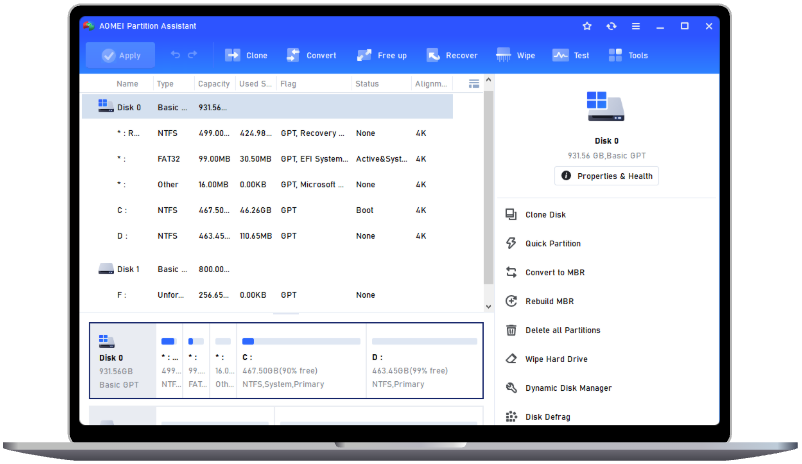How to Format an SD card for a Dash Cam?
This post provides a step-by-step guide on how to format an SD card for a dash cam. Whether you're setting up a new SD card or troubleshooting an existing one, this article will help you resolve issues with ease.
A dash cam (dashboard camera) is a small camera mounted on a vehicle’s dashboard or windshield. It records video on a micro SD card while driving, providing proof in case of accidents. However, many users encounter issues related to SD cards while using them. Whether your dash cam is failing to record properly, displaying a "card error" message, or you're setting up a new card, formatting the SD card is a good choice to resolve these issues. This post provides a step-by-step guide on how to format an SD card for a dash cam, ensuring your device works smoothly.
Preparations before formatting an SD card for a dash cam
Before you begin the formatting process, there are some crucial steps to ensure your SD card is prepared correctly.
➤ Backup Important Data
Formatting an SD card will erase all existing files. If you have important recordings on the card, remember to save them to another storage device before proceeding.
➤ Check the SD Card Type
Dash cams typically support micro SD cards in FAT32 or exFAT format. You can check your dash cam’s SD card requirements in the user manual or manufacturer’s website. This can help you select the right file system when formatting.
➤ Ensure Proper Connection
Insert the SD card into an SD card reader and connect it to your PC. If your computer doesn't detect it, try using another reader or USB port.
How to format an SD card for a dash cam on Windows?
Once you've completed these preparations, you can proceed with one of the formatting methods below. Here are three practical ways to format an SD card for a dash cam on Windows. Choose the one that best suits your needs.
Fix 1. Format SD card via DiskPart
DiskPart is a powerful command-line tool built into Windows that allows you to format storage devices. If you are familiar with command lines, follow these steps to format your micro SD card for a dash cam:
Step 1. Press “Windows + R” to open the Run dialogue; then type “cmd” to open the Command Prompt.
Step 2. In the CMD window, type “diskpart” and press Enter.
Step 3. Type the following commands and press Enter after each one.
● list disk
● select disk 1
● list partition
● select partition 1
● format fs=exFAT quick (exFAT can be replaced with FAT32, or other file systems)
Fix 2. Format the SD card via Disk Management
Alternatively, you can use Disk Management to format your micro SD card for a dash Cam. This method is suitable for users who prefer a simpler approach.
Step 1. Press “Windows +R” to open the Run box, type “diskmgmt.msc” and hit the “Enter” key to run Disk Management.
Step 2. Locate the SD card and right-click it. Then choose “Format”.
Step 3. In the pop-up window, set the SD card file system as needed.
Step 4. Then, click “OK”. The SD card file system will be formatted within a few seconds.
Fix 3. Format SD card Using AOMEI Partition Assistant
AOMEI Partition Assistant is a powerful third-party tool that simplifies the SD card formatting process and offers advanced partition management features. Unlike Windows' built-in tools, this software allows you to format an SD card to exFAT, FAT32, NTFS, and Ext2, Ext3, Ext4 using an intuitive interface. If you’ve encountered formatting failures with Disk Management or DiskPart, AOMEI Partition Assistant provides a reliable alternative.
★ Supports formatting SD cards, USB drives, HDDs, SSDs, and other storage devices.
★ Offers a wide range of disk management features to optimize performance, including resizing partitions, cloning disks, and migrating the OS.
★ Provides a user-friendly interface and helps eliminate common formatting errors.
★ Fully compatible with Windows 11, 10, 8.1, 8, 7, and Windows Server.
Follow these steps to format your SD card using AOMEI Partition Assistant:
Step 1. Launch AOMEI Partition Assistant, right-click on the SD card on the main interface, and choose “Format Partition”.
Step 2. In the pop-up window, choose a file system as needed and click “OK”.
Step 3. Click “Apply” and to start the formatting. Then wait for a while, your SD card will be formatted.
Best Practices for Dash Cam SD Card Maintenance
With proper practices, you can ensure smooth recording, prevent data loss, and extend the card’s lifespan. Follow these practices to keep your SD card in top condition.
✔️ Format Regularly: Over time, SD cards can accumulate fragmented data, which may lead to corruption or recording failures. It’s recommended to format the SD card at least once a month to clear old data and refresh its storage structure.
✔️ Avoid Frequent Removal: Constantly removing and reinserting the SD card increases the risk of physical damage to the connectors. This can also lead to file system errors.
✔️ Check for Errors: SD cards can develop bad sectors or encounter file system issues over time. Regularly checking the card for errors helps detect problems early.
✔️ Backup Important Videos: Dash cams loop record, meaning older footage gets overwritten as new recordings are made. If you need to keep specific footage, back up the files to your computer or cloud storage immediately. This prevents accidental loss of critical video evidence.
Final Words
This post provides three practical ways to format an SD card Using AOMEI Partition Assistant is highly recommended due to its user-friendly interface and advanced features. Now that you know how to format an SD card for a dash cam, follow these steps to optimize your device’s performance and prevent recording issues!


